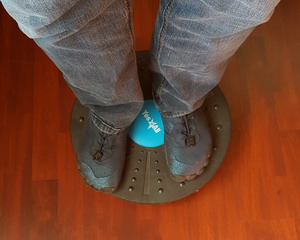 A couple of weeks ago I stepped on the rocker balance board in the corner of my office to test my balance with my eyes closed. I failed miserably. I have been slacking off in doing my balance exercises. We will blame the Covid-19 lock-down since it seems to be a good excuse for all sorts of
things. Clearly, with a lock-down happening, I can't be expected to stand on one foot with my eyes closed. Previously, I had been able to balance on that rocker board quite well. Well, I am always telling patients that the balance system is just like muscles – use it or lose it. If you are stuck in bed (or on the couch watching TV), within two weeks you lose half the function of your balance nerves.
A couple of weeks ago I stepped on the rocker balance board in the corner of my office to test my balance with my eyes closed. I failed miserably. I have been slacking off in doing my balance exercises. We will blame the Covid-19 lock-down since it seems to be a good excuse for all sorts of
things. Clearly, with a lock-down happening, I can't be expected to stand on one foot with my eyes closed. Previously, I had been able to balance on that rocker board quite well. Well, I am always telling patients that the balance system is just like muscles – use it or lose it. If you are stuck in bed (or on the couch watching TV), within two weeks you lose half the function of your balance nerves.
Since that test, I have been practicing what I preach. But I have been discovering that simply doing what I have been showing to patients is woefully 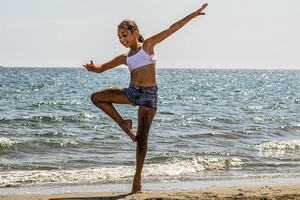 inadequate. I tell them to find a doorway or countertop and simply close their eyes and try to balance on one foot, using the wall or counter to catch
themselves as they start to fall. This did not seem like a big deal back when my balance was good, but now all of a sudden it is not so easy. Without the normal activities that keep my balance in shape, I find that the muscle strength in my feet for balance is lost. Just staying on one foot for more than a few seconds is very unstable. I am having to back up and start with strength training for my feet. I have never before thought of that as a possible issue for
patients. Consequently, I have been designing a full spectrum balance rehabilitation program that starts from the most basic “I have no balance at all” level. I do start with the assumption that you can stand up because if you can't there are larger issues than balance that need to be addressed first.
inadequate. I tell them to find a doorway or countertop and simply close their eyes and try to balance on one foot, using the wall or counter to catch
themselves as they start to fall. This did not seem like a big deal back when my balance was good, but now all of a sudden it is not so easy. Without the normal activities that keep my balance in shape, I find that the muscle strength in my feet for balance is lost. Just staying on one foot for more than a few seconds is very unstable. I am having to back up and start with strength training for my feet. I have never before thought of that as a possible issue for
patients. Consequently, I have been designing a full spectrum balance rehabilitation program that starts from the most basic “I have no balance at all” level. I do start with the assumption that you can stand up because if you can't there are larger issues than balance that need to be addressed first.
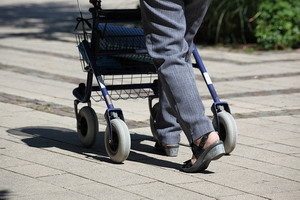 Last week I had a patient who could walk just fine as long as she was holding onto a walker. If she took her hands off the walker, she felt unsteady and had a fear of falling. The balance and coordination nerves in her hips, legs, and feet were not telling her brain where she was positionally. She
had come to rely on the nerves in her hands to tell her where she was relative to the ground. If she held my hands, she could walk forward to the adjusting table, but she could not do this without her hands holding onto something for balance. This had nothing to do with dizziness, ear, or eye issues. Even standing still was a challenge if she closed her eyes. This is someone who has to start at square one with balance training.
Last week I had a patient who could walk just fine as long as she was holding onto a walker. If she took her hands off the walker, she felt unsteady and had a fear of falling. The balance and coordination nerves in her hips, legs, and feet were not telling her brain where she was positionally. She
had come to rely on the nerves in her hands to tell her where she was relative to the ground. If she held my hands, she could walk forward to the adjusting table, but she could not do this without her hands holding onto something for balance. This had nothing to do with dizziness, ear, or eye issues. Even standing still was a challenge if she closed her eyes. This is someone who has to start at square one with balance training.
Square 1:
- Stand with your feet shoulder-width apart and close your eyes. Once you can do this comfortably for 15 seconds, work through the more challenging balancing techniques below.
- Eyes closed. Do a slow-motion squat with your feet shoulder-width apart
- Eyes open. Stand with your feet completely together for 15 seconds.
 Eyes closed. Stand with your feet completely together for 15 seconds.
Eyes closed. Stand with your feet completely together for 15 seconds.- Eyes closed and feet together. Do a slow-motion squat.
- Eyes open. Stand on a balance pad for 15 seconds with feet together.
- Eyes open. Stand with your feet together and one foot 6 inches ahead of the other for 15 seconds. Do both sides.
- Eyes closed. Stand with your feet together and one foot 6 inches ahead of the other for 15 seconds. Do both sides.
- Eyes closed. Stand with your feet together and place one foot 6 inches ahead of the other and do a slow squat. Do both sides.
- Eyes closed. Stand on a balance pad for 15 seconds.
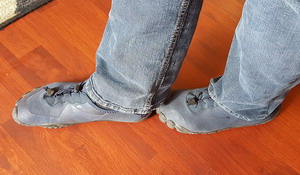 Eyes open. Stand straight heel to toe for 15 seconds. Do both sides.
Eyes open. Stand straight heel to toe for 15 seconds. Do both sides.- Eyes closed. Stand straight heel to toe for 15 seconds. Do both sides.
- Eyes open. Stand on one foot for 15 seconds. Do both sides
- Eyes open. Stand on one foot on a balance pad for 15 seconds. Do both sides.
- Eyes closed. Stand on one foot for 15 seconds. Do both sides.
- Eyes closed. Stand on one foot on a balance pad for 15 seconds. Do both sides.
- Eyes closed. Stand on one foot on a rocker board for 15 seconds. Do both sides.
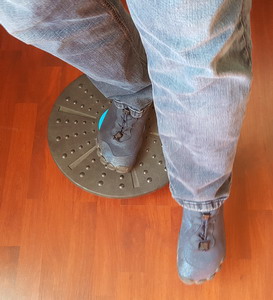 Eyes closed. Stand on one foot on a wobble board for 15 seconds. Do both sides.
Eyes closed. Stand on one foot on a wobble board for 15 seconds. Do both sides.
As you can see this creates a progression of skill building to produce excellent balance. To engage this protocol, start with step 1 and proceed following the steps in order until you can not achieve the given goal. This will establish your present skill level. From this point practice the last step you could fully accomplish plus the challenge step. If you are able, do this several times each
day. This should only take about 30 seconds to do each time and for most of the steps this can be done anywhere and anytime.
 What we are doing here is building neural pathways both in the brain's balance centers and in the reflex connections between the joints and muscles that travel to the spine and back. We are building stronger communication pathways from the joints and muscles to the brain that tell the brain what your posture
and position is relative to the environment at all times. Why is this important? It is this feedback loop that keeps us from falling flat on our face when we try to walk, and it keeps our muscles from tearing themselves apart by working against each other. I know from listening to patients how often they report that they didn't do anything to cause their back to go out. A lack of muscle coordination and balance is usually the hidden cause behind these issues.
You don't have to do anything to cause your back or your neck to “go out”. Weak balance nerves is all it takes, and unfortunately what causes this weakness is what we are not doing. It is the lack of regular engagement of these systems that causes them to break down. They need constant daily stimulation. “Use it or lose it” is not just a cute phrase, it is the law in the body.
What we are doing here is building neural pathways both in the brain's balance centers and in the reflex connections between the joints and muscles that travel to the spine and back. We are building stronger communication pathways from the joints and muscles to the brain that tell the brain what your posture
and position is relative to the environment at all times. Why is this important? It is this feedback loop that keeps us from falling flat on our face when we try to walk, and it keeps our muscles from tearing themselves apart by working against each other. I know from listening to patients how often they report that they didn't do anything to cause their back to go out. A lack of muscle coordination and balance is usually the hidden cause behind these issues.
You don't have to do anything to cause your back or your neck to “go out”. Weak balance nerves is all it takes, and unfortunately what causes this weakness is what we are not doing. It is the lack of regular engagement of these systems that causes them to break down. They need constant daily stimulation. “Use it or lose it” is not just a cute phrase, it is the law in the body.
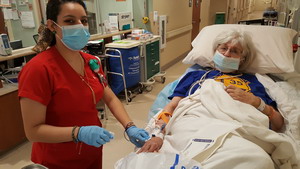 I recently had my sweetie pie, Ellen, end up in the hospital because of a fall caused by a lack of balance. As a consequence of the fall, her leg impacted the chair next to the bed and damaged the muscles and ligaments in the front of her left leg so badly that she can not put any weight on that leg. She is
already hemiplegic on that side due to the stroke she had six years ago. Fortunately, I was there to help her, otherwise, she would have been stuck there on the floor forever. Now she has to spend weeks in a rehab facility to heal and retrain that leg enough that she is able to get into her wheelchair so she can function somewhat on her own. Otherwise, she is bedridden. Balance issues are not to be taken lightly, yet since we don't notice they are a problem until we
really need balance in an emergency, they hide from us. Unless you challenge your balance system regularly, you will generally have no idea you even have a problem. Look at myself and how my balance degenerated over the last year, and I know better!
I recently had my sweetie pie, Ellen, end up in the hospital because of a fall caused by a lack of balance. As a consequence of the fall, her leg impacted the chair next to the bed and damaged the muscles and ligaments in the front of her left leg so badly that she can not put any weight on that leg. She is
already hemiplegic on that side due to the stroke she had six years ago. Fortunately, I was there to help her, otherwise, she would have been stuck there on the floor forever. Now she has to spend weeks in a rehab facility to heal and retrain that leg enough that she is able to get into her wheelchair so she can function somewhat on her own. Otherwise, she is bedridden. Balance issues are not to be taken lightly, yet since we don't notice they are a problem until we
really need balance in an emergency, they hide from us. Unless you challenge your balance system regularly, you will generally have no idea you even have a problem. Look at myself and how my balance degenerated over the last year, and I know better!
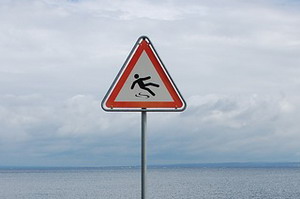 So often I see patients and the first thing they say to me is “I fell." Then comes the list of everything that hurts. Falling is not a good thing for you. I don't recommend it. Having good balance is the only thing I know of that helps you prevent falls. In the older
population, falls are one of the leading causes of death because the fall creates bed confinement which in turn sets up the conditions for pneumonia. But falls are not just an older person thing. I treat folks of all ages for injuries from falls. Engaging the protocols above is about the best thing you can do to prevent fall-related injuries. And since we are only talking a couple of minutes a day, it is well worth it.
So often I see patients and the first thing they say to me is “I fell." Then comes the list of everything that hurts. Falling is not a good thing for you. I don't recommend it. Having good balance is the only thing I know of that helps you prevent falls. In the older
population, falls are one of the leading causes of death because the fall creates bed confinement which in turn sets up the conditions for pneumonia. But falls are not just an older person thing. I treat folks of all ages for injuries from falls. Engaging the protocols above is about the best thing you can do to prevent fall-related injuries. And since we are only talking a couple of minutes a day, it is well worth it.
Take care,
David
Cost of living fee adjustment time again. Since our last adjustment in mid 2017 the cost of living in our area has gone up 10.5%. To keep pace with rising costs, our standard visit charge will become $69 and the Medicare charge will be $46. This will begin July 1st.
Thanks
Now available, Dr. Dave's Ice Cream Mix - only $10
Just add the mix to a can of coconut milk and blend it on high until it becomes somewhat foamy. Add the flavors or fruit of your choice - chocolate, vanilla, raspberry, root beer, even orange juice concentrate - let your imagination go wild! Put everything into a  saucepan and gently heat the mixture while stirring constantly until
it just begins to thicken. Take off heat immediately and then pour everything into a container to put into your freezer. In 8 to 12 hours your personal flavor of dairy free sugar free ice cream will be ready to eat! Enjoy! Depending upon what flavors you put into the mix, this recipe makes about one quart of velvety rich ice cream.
saucepan and gently heat the mixture while stirring constantly until
it just begins to thicken. Take off heat immediately and then pour everything into a container to put into your freezer. In 8 to 12 hours your personal flavor of dairy free sugar free ice cream will be ready to eat! Enjoy! Depending upon what flavors you put into the mix, this recipe makes about one quart of velvety rich ice cream.
We have received a third batch of  copies of my book The Balanced Life. They are available in the office for $17.99, and they are also
available on Amazon.com
copies of my book The Balanced Life. They are available in the office for $17.99, and they are also
available on Amazon.com
Ellen update:
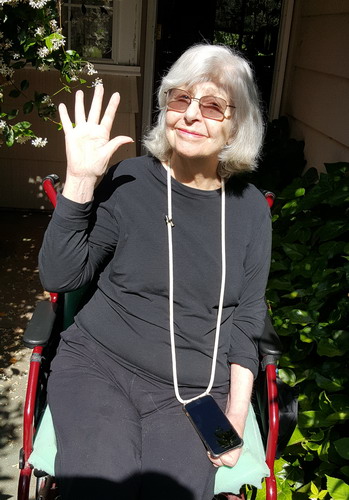 After three weeks of medical vacation, Ellen has returned home. Two tours of the beautiful Folsom Sutter hospital and a couple weeks of basking in the sanitized air in isolation at ManorCare post acute rehabilitation has been quite the holiday. What can you say after all that much fun? Now we
get to start rehabbing Ellen from her rehab. Three weeks in bed has left her muscles in deplorable shape. She is now a poster child for the very issues I am talking about in this newsletter. Slow and steady is now the order of the day as we rebuild her strength and balance as much as we are able.
After three weeks of medical vacation, Ellen has returned home. Two tours of the beautiful Folsom Sutter hospital and a couple weeks of basking in the sanitized air in isolation at ManorCare post acute rehabilitation has been quite the holiday. What can you say after all that much fun? Now we
get to start rehabbing Ellen from her rehab. Three weeks in bed has left her muscles in deplorable shape. She is now a poster child for the very issues I am talking about in this newsletter. Slow and steady is now the order of the day as we rebuild her strength and balance as much as we are able.

